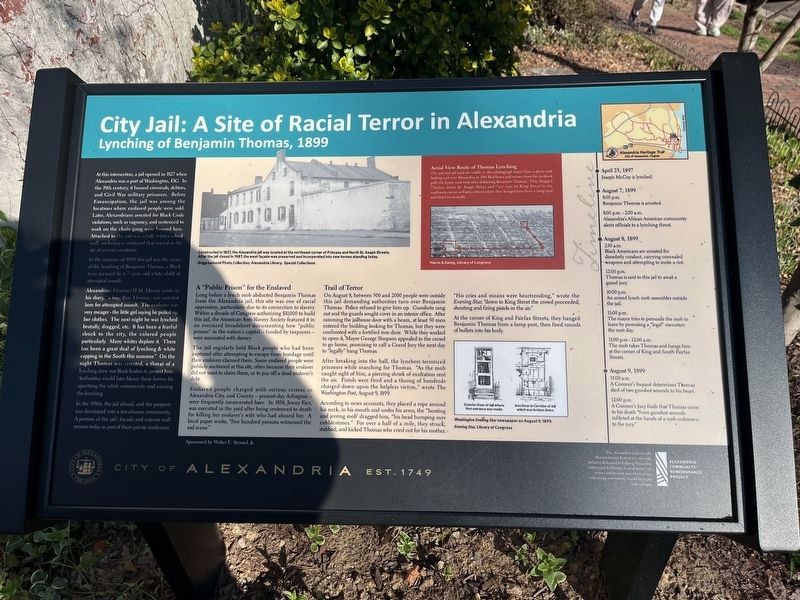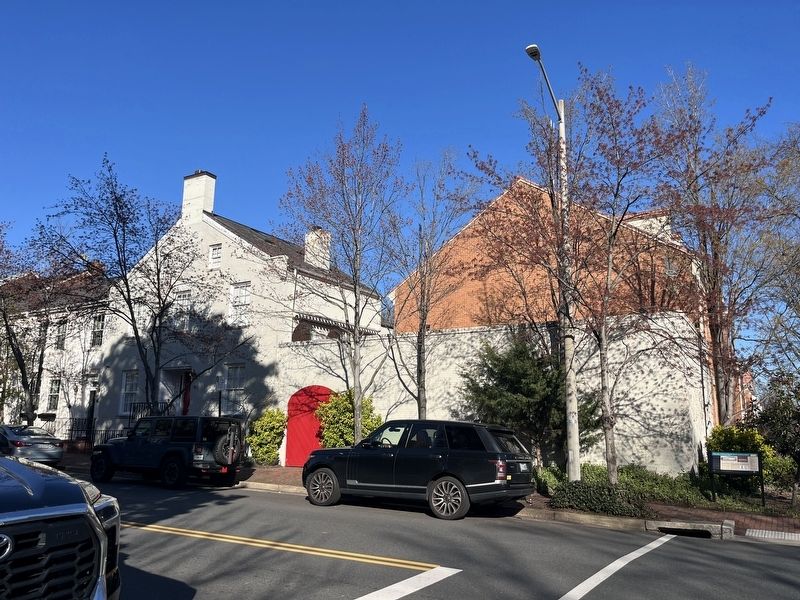Old Town in Alexandria, Virginia — The American South (Mid-Atlantic)
City Jail: A Site of Racial Terror in Alexandria
Lynching of Benjamin Thomas, 1899
— City of Alexandria, Est. 1749 —

Photographed By Devry Becker Jones (CC0), March 16, 2024
1. City Jail: A Site of Racial Terror in Alexandria Marker
At this intersection, a jail opened in 1827 when Alexandria was a part of Washington, D.C. In the 19th century, it housed criminals, debtors, and Civil War military prisoners. Before Emancipation, the jail was among the locations where enslaved people were sold. Later, Alexandrians arrested for Black Code violations, such as vagrancy, and sentenced to work on the chain gang were housed here. Attached to the ail was a tall, whitewashed wall, enclosing a courtyard that served as the site of several executions.
In the summer of 1899, this jail was the scene of the lynching of Benjamin Thomas, a Black teen accused by a 7-year-old white child of attempted assault.
Alexandrian Freeman H.M. Murray wrote in his diary, "a boy, Ben Thomas, was arrested here for attempted assault. The evidence was very meager - the little girl saying he pulled up her clothes. The next night he was lynched brutally, dragged, etc. It has been a fearful shock to the city, the colored people particularly. Many whites deplore it. There has been a great deal of lynching & white capping in the South this summer." On the night Thomas was arrested, a threat of a lynching drew out Black leaders to protect him. Authorities would later blame these heroes for upsetting the white community and causing the lynching.
In the 1980s, the jail closed, and the property was developed into a townhouse community. A portion of the jail's facade and exterior wall remain today as part of these private residences.
A "Public Prison" for the Enslaved
Long before a lynch mob abducted Benjamin Thomas from the Alexandria ail, this site was one of racial oppression, particularly due to its connection to slavery. Within a decade of Congress authorizing $10,000 to build this jail, the American Anti-Slavery Society featured it in an oversized broadsheet documenting how "public prisons" in the nation's capital — funded by taxpayers — were associated with slavery.
The jail regularly held Black people who had been captured after attempting to escape from bondage until their enslavers claimed them. Some enslaved people were publicly auctioned at this site, often because their enslaver did not want to claim them, or to pay off a dead enslaver's debt.
Enslaved people charged with serious crimes in Alexandria City, and County — present-day Arlington — were frequently incarcerated here. In 1858, Jenny Farr, was executed in the yard after being sentenced to death for killing her enslaver's wife who had abused her. A local paper wrote, "five hundred persons witnessed the sad scene."
Trail of Terror
On August 8, between 500 and 2000 people were outside this jail demanding authorities

Photographed By Devry Becker Jones (CC0), March 16, 2024
2. City Jail: A Site of Racial Terror in Alexandria Marker
At the site of the old city jail, currently condos.
After breaking into the hall, the lynchers terrorized prisoners while searching for Thomas. "As the mob caught sight of him, a piercing shriek of exultation rent the air. Pistols were fired and a throng of hundreds charged down upon the helpless victim," wrote The Washington Post, August 9, 1899.
According to news accounts, they placed a rope around his neck, in his mouth and under his arms, the "hooting and jeering mob" dragged him, "his head bumping over cobblestones." For over a half a mile, they struck, stabbed, and kicked Thomas who cried out for his mother.
"His cries and moans were heartrending," wrote the Evening Star, "down to King Street the crowd proceeded, shouting and firing pistols in the air."
At the corner of King and Fairfax Streets, they hanged Benjamin Thomas from a lamp post, then fired rounds of bullets into his body.
Timeline
• April 23, 1897
Joseph McCoy is lynched.
• August 7, 1899
8:00 p.m.
Benjamin Thomas is arrested.
8:00 p.m. - 2:00 a.m.
Alexandria's African American community alerts officials to a lynching threat.
• August 8, 1899
2:30 a.m.
Black Americans are arrested for disorderly conduct, carrying concealed weapons and attempting to incite a riot.
12:00 p.m.
Thomas is sent to this jail to await a grand jury.
10:00 p.m.
An armed lynch mob assembles outside the jail.
11:00 p.m.
The mayor tries to persuade the mob to leave by promising a "legal" execution the next day.
11:00 p.m. - 12:00 a.m.
The mob takes Thomas and hangs him at the corner of King and South Fairfax Streets.
• August 9, 1899
11:00 a.m.
A Coroner's Inquest determines Thomas died of two gunshot wounds to his heart.
12:00 p.m.
A Coroner's Jury finds that Thomas came to his death "from gunshot wounds inflicted at the hands of a mob unknown to the jury."
[Captions:]
Constructed in 1827, the Alexandria jail was located at the northeast corner of Princess and North St. Asaph Streets. After the jail closed in 1987, the west façade was preserved and incorporated into new homes standing today.
Aerial View Route of Thomas Lynching
The jail and jail yard are visible in this photograph taken from a plane and looking east over Alexandria in 1919. Red boxes and arrows show the six-block path the lynch mob took after abducting Benjamin Thomas. They dragged Thomas down St. Asaph Street and then east on King Street to the southwest corner at Fairfax Street where they hanged him from a lamp post and shot him to death.
Erected 2023 by City of Alexandria, Virginia; Alexandria Community Remembrance Project; sponsored by Walter E. Steimel, Jr.
Topics and series. This historical marker is listed in these topic lists: African Americans • Civil Rights • Government & Politics • Law Enforcement. In addition, it is included in the Virginia, The City of Alexandria series list. A significant historical date for this entry is August 7, 1899.
Location. 38° 48.502′ N, 77° 2.698′ W. Marker is in Alexandria, Virginia. It is in Old Town. Marker is at the intersection of North St. Asaph Street and Princess Street, on the right when traveling north on North St. Asaph Street. Touch for map. Marker is at or near this postal address: 401 North St Asaph Street, Alexandria VA 22314, United States of America. Touch for directions.
Other nearby markers. At least 8 other markers are within walking distance of this marker. Historic Street (a few steps from this marker); a different marker also named Historic Street (about 300 feet away, measured in a direct line); Potts-Fitzhugh-Lee House (about 500 feet away); Grosvenor Hospital (about 500 feet away); Lee-Fendall House (about 500 feet away); a different marker also named Lee-Fendall House (about 500 feet away); Washington-Rochambeau Route (about 500 feet away); Alexandria Library Sit-In (about 500 feet away). Touch for a list and map of all markers in Alexandria.
Credits. This page was last revised on March 18, 2024. It was originally submitted on March 17, 2024, by Devry Becker Jones of Washington, District of Columbia. This page has been viewed 70 times since then. Photos: 1, 2. submitted on March 17, 2024, by Devry Becker Jones of Washington, District of Columbia.